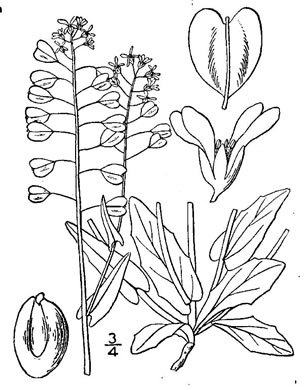Spermatophytes (seed plants): Angiosperms (flowering plants): Eudicots: Core Eudicots: Rosids: Malvids: Brassicales
WEAKLEY'S FLORA OF THE SOUTHEASTERN US (4/24/22):
Noccaea perfoliata
FAMILY
Brassicaceae
Go to FSUS key
Dig deeper at SERNEC, a consortium of southeastern herbaria.
Check out EDDMapS.org to see where this has been reported.
Read more about Perfoliate Pennycress at Vascular Plants of North Carolina.
SYNONYMOUS WITH
PLANTS NATIONAL DATABASE:
Microthlaspi perfoliatum
FAMILY
Brassicaceae
SYNONYMOUS WITH Floristic Synthesis of North America. BONAP (Kartesz, 2021)
Noccaea perfoliata
SYNONYMOUS WITH Flora of North America
Microthlaspi perfoliatum
SYNONYMOUS WITH VASCULAR FLORA OF THE CAROLINAS (Radford, Ahles, & Bell, 1968) 088-02-001:
Thlaspi perfoliatum FAMILY Brassicaceae
COMMON NAME:
Perfoliate Pennycress, Thoroughwort Pennycress
To see larger pictures, click or hover over the thumbnails.
WEAKLEY'S FLORA OF THE SOUTHEASTERN US (4/24/22):
Noccaea perfoliata
FAMILY
Brassicaceae
SYNONYMOUS WITH
PLANTS NATIONAL DATABASE:
Microthlaspi perfoliatum
FAMILY
Brassicaceae
SYNONYMOUS WITH
Floristic Synthesis of North America. BONAP (Kartesz, 2021)
Noccaea perfoliata
SYNONYMOUS WITH
Flora of North America
Microthlaspi perfoliatum
SYNONYMOUS WITH
VASCULAR FLORA OF THE CAROLINAS (Radford, Ahles, & Bell, 1968) 088-02-001:
Thlaspi perfoliatum
FAMILY
Brassicaceae
If a search such as "Carex leptalea var. leptalea" doesn't deliver the results you want, try "Carex leptalea".
Or, to minimize chances of a misspelling, try just "Carex le".
Less is more: If "pencil flower" doesn't deliver the results you want, try "pencil".


